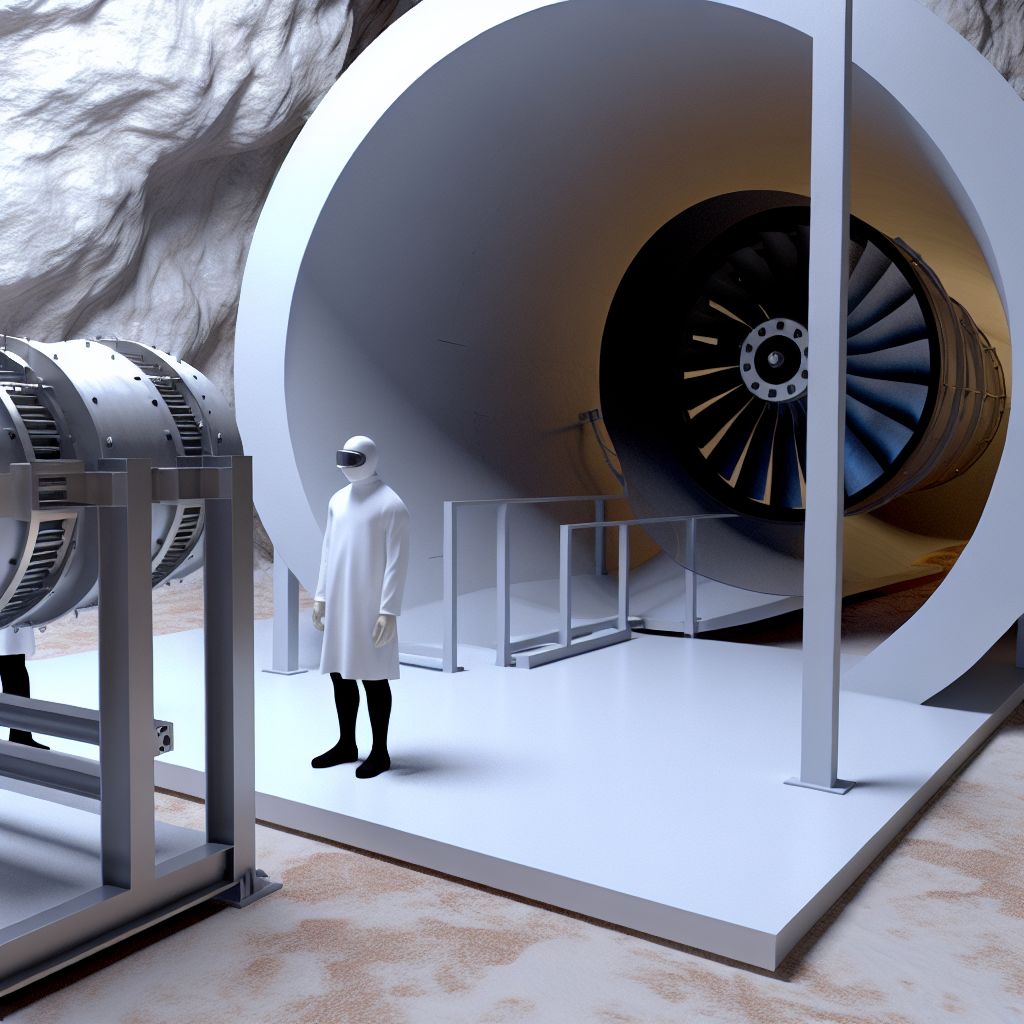Deutsch: Windkanaltests / Español: Pruebas en túnel de viento / Português: Testes em túnel de vento / Français: Essais en soufflerie / Italiano: Test in galleria del vento
Wind tunnel testing in the Space industry context involves using wind tunnels to simulate the atmospheric conditions that spacecraft, rockets, and satellite components Experience during Launch and atmospheric re-entry. These tests allow engineers to study aerodynamic forces, Heat transfer, and material behavior under conditions of high speed and varying atmospheric Pressure. By accurately replicating the flow of air and other gases around a spacecraft or its components, wind tunnel testing provides Critical data for optimizing design, improving safety and Performance, and predicting how vehicles will behave when they are actually launched into space or return to Earth.
Description

Wind tunnel testing is a crucial step in the Development and certification process for space vehicles. It enables the detailed analysis of aerodynamic properties, such as lift, drag, and stability, under controlled conditions. Engineers use Scale models or full-size replicas of spacecraft or components in the wind tunnel to measure the effects of airspeed, angle of attack, and other parameters. This testing is essential for determining the optimal shape and structure of space vehicles, ensuring they can withstand the stresses of launch and re-entry, and minimizing Fuel consumption by reducing aerodynamic drag.
Application Areas
Wind tunnel testing is applied in several key areas within the space industry, including:
- Launch Vehicle Design: Assessing and refining the aerodynamics of rockets and space shuttles to ensure stability and efficiency during Ascent through the Earth's Atmosphere.
- Spacecraft and Satellite Aerodynamics: Evaluating the design of spacecraft and satellites for aerodynamic efficiency, particularly for those that will enter or return through the atmosphere.
- Re-entry Vehicles: Testing heat shield designs and materials to ensure they can protect spacecraft from the intense heat generated during atmospheric re-entry.
- Deployable Structures: Examining how parachutes, solar sails, and other deployable structures behave under aerodynamic forces.
Well-Known Examples
- NASA's Langley Research Center: Home to several wind tunnels used for testing spacecraft designs and technologies, including those used in the Apollo missions and the Space Shuttle program.
- SpaceX: Conducts wind tunnel testing on its Dragon capsules and Falcon rockets to optimize their shapes for aerodynamic performance and heat resistance during launch and re-entry.
- European Space Agency (ESA): Uses wind tunnel testing for its spacecraft, such as the Automated Transfer Vehicle (ATV) and the ExoMars mission, to study their aerodynamic properties and thermal protection systems.
Treatment and Risks
Conducting wind tunnel testing involves careful consideration of:
- Model Scaling: Ensuring that the scale models used in the wind tunnel accurately represent the aerodynamic behavior of the full-size vehicle.
- Simulation Accuracy: Accurately simulating the atmospheric conditions at different altitudes and velocities to ensure that the test results are relevant to real-world conditions.
- Data Interpretation: Correctly interpreting the data obtained from wind tunnel tests to make informed design decisions, which requires a deep understanding of aerodynamics and Engineering principles.
Similar Terms or Synonyms
- Aerodynamic testing
- Aerospace wind tunnel experiments
- Atmospheric Flight simulation tests
Summary
Wind tunnel testing is a pivotal process in the space industry, providing essential data on aerodynamic forces and heat transfer that influence the design and performance of spacecraft, rockets, and satellites. Through these tests, engineers can refine designs to improve safety, efficiency, and performance, ensuring that vehicles are capable of withstanding the demanding conditions of launch, spaceflight, and re-entry.
--
Related Articles to the term 'Wind tunnel testing' | |
| 'Mechanical Stress' | ■■■■■■■ |
| Mechanical Stress in the Space industry refers to the internal forces that materials and structures Experience . . . Read More | |
| 'Mechanics' | ■■■■■■■ |
| Mechanics is the branch of physics that deals with the study of motion, forces, and energy in a system. . . . Read More | |
| 'Streamlining' | ■■■■■■■ |
| Streamlining in the Space industry context refers to the design and engineering process aimed at reducing . . . Read More | |
| 'Fluid' | ■■■■■■■ |
| Fluid: In physics, a fluid is a liquid, gas, or other material that continuously deforms (flows) under . . . Read More | |
| 'UHV' | ■■■■■■ |
| In the aerospace context, \'UHV\' stands for \'Ultra-High Vacuum.\' UHV refers to a vacuum with a pressure . . . Read More | |
| 'Launchpad' | ■■■■■■ |
| Launchpad: In the Space industry context, a launchpad is a complex and specially designed site equipped . . . Read More | |
| 'Conductor' | ■■■■■■ |
| Conductor: In the Space industry context, a conductor refers to materials or substances that permit the . . . Read More | |
| 'Aircraft flight mechanics' | ■■■■■■ |
| Aircraft flight mechanics: Aircraft Flight mechanics in the Space industry refers to the principles and . . . Read More | |
| 'Reentry' | ■■■■■■ |
| Reentry is a critical phase of a spacecraft or a missile\'s mission, where it enters the Earth\'s atmosphere . . . Read More | |
| 'Catapult' | ■■■■■■ |
| In the aerospace context, a catapult is a device that is used to launch aircraft from a runway or a deck . . . Read More | |
